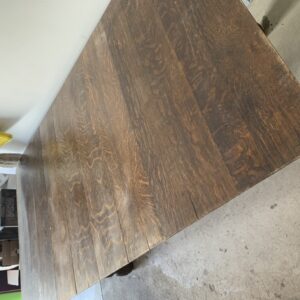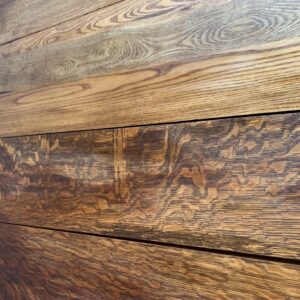Hello,
Total novice here who recently took up refinishing furniture as a hobby. I bought an antique quarter sawn white oak dining table. It came with four leaves which were slightly different in color than the main table. I attributed the difference to lack of use. However when I stripped the old stain I discovered that the four leaves are flat sawn white oak and they had been a faux quarter sawn finish that made them appear to match the table. I’m concerned when refinishing that the difference in grain between the main table and leaves will look terrible. Photos from before and after stripping attached.
Any thoughts on how to make it look cohesive without buying new quarter sawn boards to make new leaves?


















Replies
New wood.
Was trying to avoid that but it may be inevitable. Thanks! 😊
That was an awesome paint job! Even new wood may not match up well given the age diffs, but as you said, the leaves are not out all the time so it will seem to make sense. That grain will be an eyesore, which is why they painted it. New wood, and buy extra to test for your finishing to try and marry them up.
Thanks! 😊
I think it depends on how the table top will be displayed most of the time. I think that frequently, when you have a large gathering and you need all of the leaves, you will usually have a table cloth on it anyway. I have a friend with an extendable table, but he didn't have the leaves for it. He asked me to make some, but he didn't care what kind of wood was used because the table was always covered when he needed to have the leaves in. Of course, if you are refinishing it to sell it, then you need to get some quarter sawn wood and make new leaves. You might consider applying some q-sawn veneer. It might be less costly.
Thanks for the veneer tip! I might do that! I plan to leave two of the leaves in permanently so that will help I think. Need to find a planer so I can accommodate the thickness of the veneer! 😊
Good suggestions here and I don't believe a faux quartersawn finish exists. It appears the table was simply uniformly finished to blend the grains.
Yes, I agree. That’s what I was attempting to say when I called it a faux quarter sawn finish! Just wasn’t able to articulate that very well! 😂🤷🏻♀️
I had an interior door that I believed to be quartersawn white oak. It turned out to be a fantastic faux paint job.
As someone above said, if the leaves are only going to be in during special occasions, I'd think about just leaving it under a tablecloth. If it's out all the time, I would buy new QS lumber and try to match it to the rest of the table.
Thanks! 😊
As I recall, Gustav Stickley made and sold lots of oak furniture in which the medullary ray look was painted on with a patterned roller. Despite this being a rather ugly thing (its a matter of taste, though) such furniture is now regarded as real-antique in the sense of being representative of a famous genre and also valuable in its as-it-was-made condition.
It might have been a mistake to strip off that painted grain ...........
Lataxe
Maybe. I don’t know enough about antiques to judge if it had any real value since it’s overall condition was not great. Even so, not sure how pointing that out after the fact is helpful. 🤷🏻♀️
Being helpful is not my only mode, as I am a self-centred little skinbag (like all the other humans) inclined to indulge in all sorts of remarks.
Of course, should you now encounter a Gustav Stickley antique going cheap or even tossed to the kerb, you will at least pause to consider what to do with it before knowing what to do with it until you've found out what it would be best to do with it. This is known as "being cautious" and also "learning from my mistakes". :-)
Lataxe
“[Deleted]”
My partner’s business is faux finishes. She can make any wood look like any species she wants, or granite and marble. Of course, she has years of experience, but she just told me there are some simple basic steps that anyone can do to get the effect good enough. Just Google “Faux finish to make flat sawn look like quarter sawn”, you’ll find dozens, if not hundreds of how-to’s. Here’s just one of many Youtube videos to show how to do it: https://m.youtube.com/watch?v=ExHVeUCXwPY Here’s a step by step: https://www.google.com/amp/s/www.oldhouseonline.com/.amp/repairs-and-how-to/create-faux-wood-grain-finish
Hard to tell from just pics but the OP's original table top looks very much like mine did before I simply sanded, stained, and refinished it to match the base. We have enjoyed it like that for the last 25 years. I kept one leaf in original condition for the sake of posterity.
Regardless of what you do, the table appears to be a solid, well built piece of character furniture (from the little that I could see, those legs look awesome too and appear to be nicely carved)
My table is a depression era family heirloom full of character ( dents, scratches, nicks, saw marks etc.) and I cherish every one so changing out the top was a non starter. The top was originally covered with veneerite, which is faux wood grain printed on paper and stuck onto a solid wood substrate. I have the matching cabinet still covered in the original faux "QS white oak" veneerite.
Quote from inter-web on veneerite: "Furniture using veneerite is a decided step down from pieces with actual hardwood veneers, but it does help identify a truly vintage depression-era piece. It was a technique that allowed for a more elegant look for people who simply couldn't afford the real thing during these austere times".
Tip for your next project: A peek at the underside of the table will confirm whether there is some type of veneer or other covering on the topside. If the grain does not match up then the bottom side at least serves as a proxy for what the stripped and refinished top will look like.
Cheers
“[Deleted]”
This forum post is now archived. Commenting has been disabled